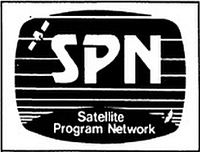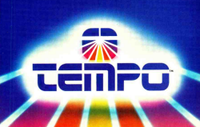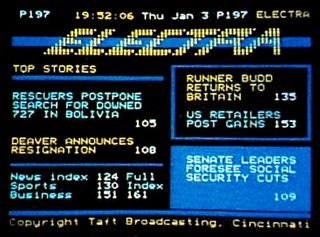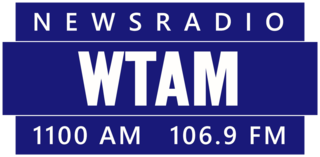
Satellite Program Network (SPN) was a satellite and cable television network that broadcast in the United States from 1979 to 1989. Following a name change to Tempo Television in 1986, it was bought by NBC and relaunched as CNBC in 1989.

Satellite Program Network (SPN) was a satellite and cable television network that broadcast in the United States from 1979 to 1989. Following a name change to Tempo Television in 1986, it was bought by NBC and relaunched as CNBC in 1989.
This section needs additional citations for verification .(April 2019) |
SPN was created by Ed Taylor, an associate of Ted Turner and the head of the Southern Satellite Systems company. The network, which began in 1979, was the second-oldest cable-only network. In 1985, SPN was acquired by Satellite Syndicated Systems. [1]
Among the programs broadcast on SPN were Video Concert Hall , an early music video show (before the launch of MTV); News from Home, a program for Canadians in the US, hosted by early CNN news anchor Don Miller; The Shopping Game , a Nicholson-Muir game show produced in Nashville and hosted by Art James; The Susan Noon Show, featuring celebrity interviews; Nutrition Dialogue, hosted by Dr. Betty Kamen; Sewing with Nancy ; The Paul Ryan Show, another celebrity interview program with the actor/interviewer of the same name; and Moscow Meridian, a current-affairs program produced by Soviet authorities and hosted by Vladimir Posner. Reruns of old situation comedies and movies, mostly from low-budget studios, rounded out the schedule.
In 1984, the National Collegiate Athletic Association (NCAA) paid SPN to broadcast some college football games of the Division I-AA playoffs, including that season's championship game, [2] following a Supreme Court ruling ( NCAA v. Board of Regents of the University of Oklahoma ) that halted the NCAA's practice of negotiating television contracts for its members. [3]

In March 1986, Satellite Syndicated Systems changed its name to Tempo Enterprises, and SPN and SPN International were changed to Tempo Television and Tempol International, respectively. [4] [5] Tempo Television was a 24-hour national cable network serving all contiguous states, Alaska, Hawaii and Puerto Rico.
Using a counter-programming philosophy, Tempo Television fulfilled viewer needs by dividing its program schedule into various dayparts including international programming, finance, sports, leisure and classic films. Market studies clearly indicated that this unique programming approach attracted and retained upscale audiences who were looking for entertainment that was informative and substantially different from the standard options.[ citation needed ]
A Canadian regulatory description of the channel in 1988 said that Tempo's "schedule consists of outdoors, travel, general information and entertainment programming and classic feature films that are in the public domain." [6] In May 1988, by which time Tempo had 12 million subscribers, the channel was purchased by NBC, mainly for its existing carriage and not its programming. [7] [8] It was relaunched on April 17, 1989, in a new guise as the business news channel CNBC. [9]

The National Broadcasting Company (NBC) is an American commercial broadcast television and radio network serving as the flagship property of the NBC Entertainment division of NBCUniversal, a subsidiary of Comcast. The headquarters of NBC is in New York City at the Comcast Building. NBC also has offices in Chicago at the NBC Tower.

TNT is an American basic cable television channel owned by the Warner Bros. Discovery Networks unit of Warner Bros. Discovery (WBD) that launched on October 3, 1988. TNT's original purpose was to air classic films and television series to which Turner Broadcasting maintained spillover rights through its sister station TBS. Since June 2001, the network has shifted its focus to dramatic television series and feature films, along with some sporting events, as TBS shifted its focus to comedic programming.

USA Network is an American basic cable television channel owned by the NBCUniversal Media Group division of Comcast's NBCUniversal. It was originally launched in 1977 as Madison Square Garden Sports Network, one of the first national sports cable television channels, before being relaunched under its current name on April 9, 1980. Since then, USA steadily gained popularity through its original programming, a long-established partnership with WWF/WWE and, for many years, limited sports programming that increased significantly in 2022 after the shutdown of NBCSN.

WEWS-TV is a television station in Cleveland, Ohio, United States, affiliated with ABC. It has been owned by the E. W. Scripps Company since its inception in 1946, making it one of three stations that have been built and signed on by Scripps. WEWS-TV's studios are located on Euclid Avenue in Downtown Cleveland, and its transmitter is located in suburban Parma.

Double Dare is an American game show in which two teams compete to win cash and prizes by answering trivia questions and completing messy stunts known as physical challenges. It originally ran from 1986 to 1993. A revival ran in 2000, and the most recent revival ran from 2018 to 2019.

TruTV is an American basic cable channel owned by Warner Bros. Discovery (WBD). The channel primarily broadcasts comedy, docusoaps and reality shows, as well as sports programming produced by TNT Sports.

Television is one of the major mass media outlets in the United States. In 2011, 96.7% of households owned television sets; about 114,200,000 American households owned at least one television set each in August 2013. Most households have more than one set. The percentage of households owning at least one television set peaked at 98.4%, in the 1996–1997 season. In 1948, 1 percent of U.S. households owned at least one television; in 1955, 75 percent did. In 1992, 60 percent of all U.S. households had cable television subscriptions.
Superstation is a term in North American broadcasting that has several meanings. Commonly, a "superstation" is a form of distant signal, a broadcast television signal—usually a commercially licensed station—that is retransmitted via communications satellite or microwave relay to multichannel television providers over a broad area beyond its primary terrestrial signal range.

The E. W. Scripps Company, also known as Scripps Howard, is an American broadcasting company founded in 1878 as a chain of daily newspapers by Edward Willis "E. W." Scripps and his sister, Ellen Browning Scripps. It was also formerly a media conglomerate. The company is headquartered at the Scripps Center in Cincinnati, Ohio. Its corporate motto is "Give light and the people will find their own way", which is symbolized by the media empire's longtime lighthouse logo.

Electra was a teletext service in the United States that was in operation from 1982 up until 1993, when it was shut down due to a lack of funding, and discontinuation of teletext-capable television sets by the only US television manufacturer offering teletext capability at the time, Zenith. It was owned, operated and maintained by Cincinnati-based Taft Broadcasting and Tulsa, Oklahoma-based Satellite Syndicated Systems (SSS), later known as Tempo Enterprises, in cooperation with cable/satellite TV station Superstation WTBS, who carried Electra's data on their vertical blanking interval. SSS's own TV network, the Satellite Program Network, carried the service before it was shut down in 1989. The service was also available to C-band satellite dish users via the Galaxy 1 and Satcom 3R satellites.
WBPX-TV is a television station in Boston, Massachusetts, United States, airing programming from the Ion Television network. It is owned by the Ion Media subsidiary of the E. W. Scripps Company, which also owns Woburn-licensed Grit station WDPX-TV ; the two channels share the same TV spectrum. WBPX-TV and WDPX-TV are broadcast from a tower shared with WUNI and WWJE-DT on Parmenter Road in Hudson, Massachusetts.
WVPX-TV is a television station licensed to Akron, Ohio, United States, serving the Cleveland area as an affiliate of Ion Television. Owned by Inyo Broadcast Holdings, it is jointly operated with Canton-licensed Bounce TV affiliate WDLI-TV, which transmits using WVPX-TV's full-power spectrum via a channel sharing agreement.
WQHS-DT is a television station in Cleveland, Ohio, United States, broadcasting the Spanish-language networks Univision and UniMás. Owned and operated by TelevisaUnivision, it is the only full-power Spanish-language television station in the state of Ohio. WQHS-DT's studios and transmitter are located on West Ridgewood Drive in suburban Parma.

WTAM is a commercial radio station licensed to Cleveland, Ohio, United States, and carries a news/talk and sports radio format commonly known as "Newsradio WTAM 1100". Owned by iHeartMedia, WTAM serves Greater Cleveland and much of surrounding Northeast Ohio, and is a clear-channel station with extended nighttime range. WTAM is also Northeast Ohio's primary entry point station in the Emergency Alert System.

WPCH-TV, branded on-air as Peachtree TV, is a television station in Atlanta, Georgia, United States, affiliated with The CW. It is owned by locally based Gray Television alongside CBS affiliate and company flagship WANF, and low-power, Class A Telemundo affiliate WKTB-CD. WPCH-TV and WANF share studios on 14th Street Northwest in Atlanta's Home Park neighborhood; WPCH-TV's transmitter is located in the Woodland Hills section of northeastern Atlanta.

KYOU-TV is a television station licensed to Ottumwa, Iowa, United States, serving Ottumwa and Kirksville, Missouri, as an affiliate of Fox, NBC and The CW Plus. The station is owned by Gray Television and maintains studios on West 2nd Street in Downtown Ottumwa; its transmitter is located one mile (1.6 km) east of Richland, Iowa. A translator, K30MG-D, offers additional coverage in the Kirksville area.
In American television terminology, a fourth network is a reference to a fourth commercial broadcast (over-the-air) television network, as opposed to the Big Three television networks that dominated U.S. television from the 1950s to the 1980s: ABC, CBS and NBC.
The 1984 NCAA Division I-AA Football Championship Game was a postseason college football game between the Montana State Bobcats and the Louisiana Tech Bulldogs. The game was played on December 15, 1984, at Johnson Hagood Stadium in Charleston, South Carolina. The culminating game of the 1984 NCAA Division I-AA football season, it was won by Montana State, 19–6.

WGN America was an American subscription television network that operated from November 9, 1978 to February 28, 2021. The service was originally uplinked to satellite by United Video Inc. as a national feed of Chicago independent station WGN-TV, making the station's programming available to cable and satellite providers throughout the United States as the second nationally distributed "superstation".